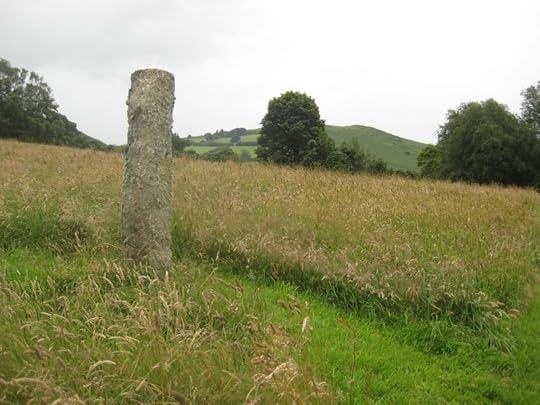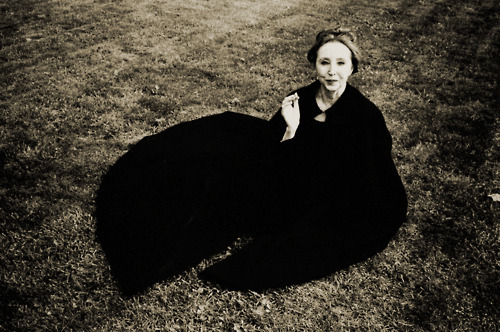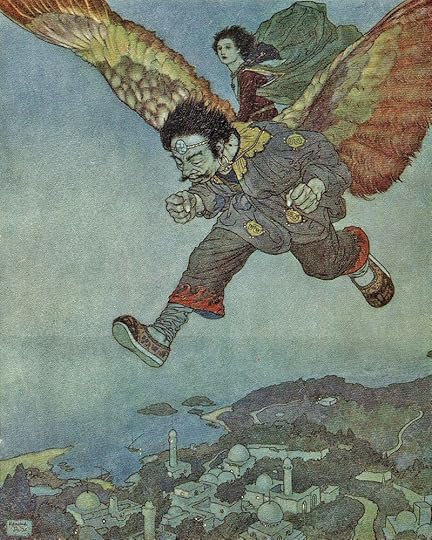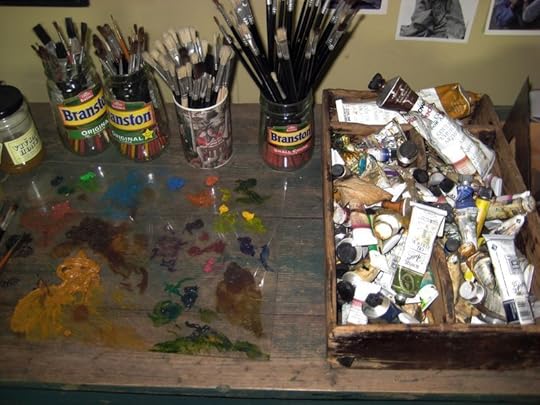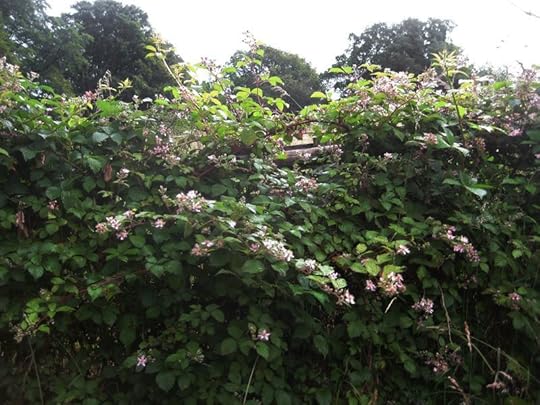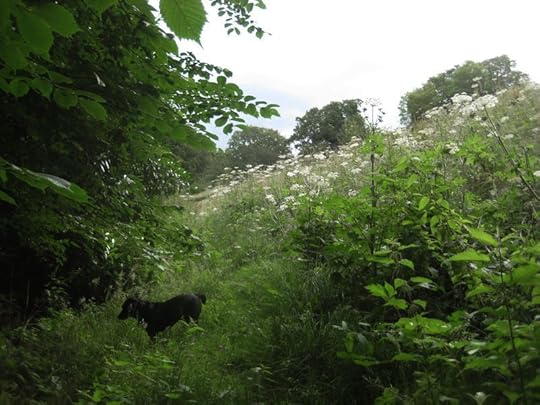Terri Windling's Blog, page 215
July 26, 2012
The art and joy of words
"A writer is a person who cares what words mean, what they say, how they say it. Writers know words are their way towards truth and freedom, and so they use them with care, with thought, with fear, with delight. By using words well, they strengthen their souls. Story-tellers and poets spend their lives learning that skill and art of using words well. And their words make the souls of their readers stronger, brighter, deeper." - Ursula K. Le Guin (from "A Few Words to a Young Writer")
“Words should wander and meander. They should fly like owls and flicker like bats and slip like cats. They should murmur and scream and dance and sing.” - David Almond (from My Name is Mina)
“If you say a word, it leaps out and becomes the truth. I love you. I believe it. I believe I am loveable. How can something as fragile as a word build a whole world?” ― Franny Billingsley (from Chime)
"Child, to say the very thing you really mean, the whole of it, nothing more or less or other than what you really mean; that's the whole art and joy of words.” ― C.S. Lewis (from Till We Have Faces)
July 25, 2012
There are hundreds of ways...
"As a poet I hold the most archaic values on earth . . . the fertility of the soil, the magic of animals, the power-vision in solitude, the terrifying initiation and rebirth, the love and ecstasy of the dance, the common work of the tribe. I try to hold both history and the wilderness in mind, that my poems may approach the true measure of things and stand against the unbalance and ignorance of our times.” - Gary Snyder
"Along with the other animals, the stones, the trees, and the clouds, we ourselves are characters within a huge story that is visibly unfolding all around us, participants within the vast imagination, or Dreaming, of the world.” - David Abram
“As symbol, or as the structuring of symbols, art can render intelligible -- or at least visible, at least discussible -- those wilderness regions which philosophy has abandoned and those hazardous terrains where science's tools do not fit. I mean the rim of knowledge where language falters; and I mean all those areas of human experience, feeling, and thought about which we care so much and know so little: the meaning of all we see before us, of our love for each other, and the forms of freedom in time, and power, and destiny, and all whereof we imagine: grace, perfection, beauty, and the passage of all materials to thoughts, and of all ideas to forms.” - Annie Dillard
“Let the beauty we love be what we do. There are hundreds of ways to kneel and kiss the ground.” ― Rumi
July 24, 2012
A soul hidden in everything
“How it is that animals understand things I do not know, but it is certain that they do understand. Perhaps there is a language which is not made of words and everything in the world understands it. Perhaps there is a soul hidden in everything and it can always speak, without even making a sound, to another soul.” - Frances Hodgson Burnett (from A Little Princess)
My prayer this morning: Let me learn the language of trees, birds, dogs, grey stones, black beetles, green grass, and all living things. And when I'm fluent in those languages, let me translate them faithfully into stories and paintings.
Happy Birthday, Tilly!
She's three years old today, all grown up...but she's still, and will always be, our pup.
“Dogs are minor angels, and I don't mean that facetiously. They love unconditionally, forgive immediately, are the truest of friends, willing to do anything that makes us happy, etcetera. If we attributed some of those qualities to a person we would say they are special. If they had all of them, we would call them angelic. But because it's 'only' a dog, we dismiss them as sweet or funny but little more. However when you think about it, what are the things that we most like in another human being? Many times those qualities are seen in our dogs every single day-- we're just so used to them that we pay no attention.” - Jonathan Carroll
“In times of joy, all of us wished we possessed a tail we could wag.” - W. H. Auden
My tail's wagging for you today, Tilly. Thank you for blessing our lives (and this blog) with your sweet self.
July 23, 2012
Lean In, Part II
"I think there is a certain age, for women, when you become fearless. It may be a different age for every woman, I don’t know. It’s not that you stop fearing things: I’m still afraid of heights, for example. Or rather, of falling — heights aren’t the problem. But you stop fearing life itself. It’s when you become fearless in that way that you decide to live.
"Perhaps it’s when you come to the realization that the point of life isn’t to be rich, or secure, or even to be loved — to be any of the things that people usually think is the point. The point of life is to live as deeply as possible, to experience fully. And that can be done in so many ways."
- Theodora Goss (from her blog post "Fearless Women")
“I've been absolutely terrified every moment of my life and I've never let it keep me from doing a single thing that I wanted to do.” - Georgia O'Keeffe
"The most difficult thing is the decision to act, the rest is merely tenacity. The fears are paper tigers. You can do anything you decide to do. You can act to change and control your life, and the procedure, the process is its own reward." - Amelia Earhart
"For too many centuries women have been being muses to artists. I wanted to be the muse, I wanted to be the wife of the the artist, but I was really trying to avoid the final issue — that I had to do the job myself." - Anaïs Nin
As Sheryl Sandberg is quoted as asking in "Lean In" (posted here almost exactly a year ago): "What would you do if you weren't afraid?"
For women especially, but also for all creators who are Outsiders in one way or another, that's a powerful question.
July 22, 2012
Tunes for a Monday Morning
This week, two songs from Dry the River, a young English band from Stratford, East London. Their musical influences range from folk and bluegrass to hardcore punk -- but I personally prefer the accoustic end of their repetoire, where the group's vocal harmonies, Will Harvey's fiddle playing, and the beautiful lyrics penned by Peter Liddle (the group's lead singer and songwriter) come to the fore.
Above, the band performs their song "History Book" in Gospel Oak, London.
Below, a haunting, stripped-down version of their song "Bible Belt," performed in a park in Stratford. This one cuts close to the bone for me, which is precisely why I love it dearly.
 Sketch above: Blue-collar Cinderella
Sketch above: Blue-collar Cinderella
"The trick of it is, don't be afraid anymore...."
July 19, 2012
Inspiration...and return
“The artist seeks contact with his intuitive sense of the gods, but in order to create his work, he cannot stay in this seductive and incorporeal realm. He must return to the material world in order to do his work. It's the artist's responsibility to balance mystical communication and the labor of creation.” - Patti Smith (from Just Kids, her excellent memoir about life and art in '70s-era New York)
As Smith says, the flight through the incorporeal realm...
...must be followed by the return to the material world...
...where we turn our visions into earthly form with the tools we find at hand.
In order to capture those all-too-fleeting visions during the potent time just after "the return," it's important, I think, that tools at hand be the ones that are truly best shaped for us...for the artists we actually are, as opposed to the artists we may have wanted to be, or felt some kind of outside pressure to be.
For some young artists, it can take a bit of time to discover which tools (which medium, or genre, or career pathway) will truly suit them best. For me, although many different art forms attract me, the tools that I find most natural and comfortable are language and oil paint; I've also learned that as someone with a limited number of spoons it's best to keep my toolbox clean and simple. My husband, by contrast, thrives with a toolbox absolutely crowded to bursting, working with language, voice, musical instruments, puppets, masks animated on a theater stage, computer and video imagery, and half a dozen other things besides, no one of these tools more important than the others, and all somehow working together. For other artists, the tools at hand might be needles and thread; or a jeweller's torch; or a rack of cooking spices; or the time to shape a young child's day....
To me, it's all art, inside the studio and out. At least it is if we approach our lives that way.
Art above: An illustration for Hans Christian Andersen's "The Garden of Paradise" by Edmund Dulac (1882-1953).
July 18, 2012
When inspiration comes
“So much in writing depends on the superficiality of one's days," said novelist Graham Greene. "One may be preoccupied with shopping and income tax returns and chance conversations, but the stream of the unconscious continues to flow undisturbed, solving problems, planning ahead: one sits down sterile and dispirited at the desk, and suddenly the words come as though from the air: the situations that seemed blocked in a hopeless impasse move forward: the work has been done while one slept or shopped or talked with friends.”
Or walked through the fields...
...past the blackberry brambles...
...in a thorn-torn skirt and muddy brown boots...
...with a faithful little black companion...
...leading the way.
July 17, 2012
Inspiration in a field of Queen Anne's Lace
“I don't know exactly where ideas come from, but when I'm working well ideas just appear. I've heard other people say similar things - so it's one of the ways I know there's help and guidance out there. It's just a matter of our figuring out how to receive the ideas or information that are waiting to be heard.” - Jim Henson
"An essential portion of any artist's labor is not creation so much as invocation. Pat of the work cannot be made, it must be received; and we cannot have this gift except, perhaps, by supplication, by courting, by creating within ourselves that 'begging bowl' to which the gift is drawn." - Lewis Hyde
"The artist is nothing without the gift, but the gift is nothing without the work." — Emile Zola
July 16, 2012
Recommended Reading
 Cinderella by Edmund Dulac (1882-1953)
Cinderella by Edmund Dulac (1882-1953)
The Los Angeles Review of Books has launched a series of essays called Fairy Tales Revisited, looking at fairy tale re-tellings past and present. The first essay is "The Nature of Cinderella" by Marie Rutkoski.
"Fairy tales are rife with transformation," write Rutkoski, "from beast to handsome prince, from dirty scullery maid to well-dressed princess. It is perhaps no coincidence that nature in the Cinderella stories facilitates transformation, for nature itself is a changeable thing, from season to season, from a sunny day to rain, from an egg to a flying bird in a matter of weeks."
Also, on the same site you'll find an interview with one of my favorite authors of the subjects of trees and forests, Robert Pogue Harrison, discussing "Deforestation in a Civilized World."
"When I'm critical of modern approaches to ecology," says Harrison, "I'm really trying to remind my reader of the long relationship that Western civilization has had to these forests that define the fringe of its place of habitation, and that this relationship is one that has a rich history of symbolism and imagination and myth and literature. So much of the Western imagination has projected itself into this space that when you lose a forest, you're losing more than just the natural phenomenon or biodiversity; you're also losing the great strongholds of cultural memory."
Indeed.
 Tilly communes with a Tree Elder
Tilly communes with a Tree Elder
I should also note that the Moveable Feast on Creative Inspiration continues to grow. You'll find the full listing (so far) on the Moveable Feast page...and do let me know if you have a new dish to add. All contributions welcome.
Terri Windling's Blog
- Terri Windling's profile
- 707 followers









